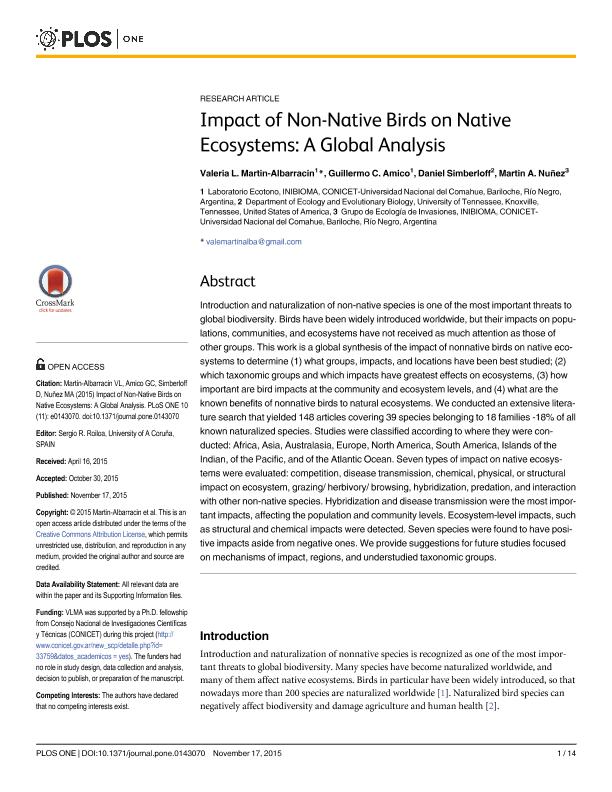Mostrar el registro sencillo del ítem
dc.contributor.author
Martin Albarracin, Valeria Leticia

dc.contributor.author
Amico, Guillermo Cesar

dc.contributor.author
Simberlof, Daniel
dc.contributor.author
Nuñez, Martin Andres

dc.date.available
2018-10-02T14:24:46Z
dc.date.issued
2015-11-17
dc.identifier.citation
Martin Albarracin, Valeria Leticia; Amico, Guillermo Cesar; Simberlof, Daniel; Nuñez, Martin Andres; Impact of non-native birds on native ecosystems: a global analysis; Public Library of Science; Plos One; 17; 2015; 17-11-2015; 1-14
dc.identifier.issn
1932-6203
dc.identifier.uri
http://hdl.handle.net/11336/61473
dc.description.abstract
Introduction and naturalization of non-native species is one of the most important threats to global biodiversity. Birds have been widely introduced worldwide, but their impacts on populations, communities, and ecosystems have not received as much attention as those of other groups. This work is a global synthesis of the impact of nonnative birds on native ecosystems to determine (1) what groups, impacts, and locations have been best studied; (2) which taxonomic groups and which impacts have greatest effects on ecosystems, (3) how important are bird impacts at the community and ecosystem levels, and (4) what are the known benefits of nonnative birds to natural ecosystems. We conducted an extensive literature search that yielded 148 articles covering 39 species belonging to 18 families -18% of all known naturalized species. Studies were classified according to where they were conducted: Africa, Asia, Australasia, Europe, North America, South America, Islands of the Indian, of the Pacific, and of the Atlantic Ocean. Seven types of impact on native ecosystems were evaluated: competition, disease transmission, chemical, physical, or structural impact on ecosystem, grazing/ herbivory/ browsing, hybridization, predation, and interaction with other non-native species. Hybridization and disease transmission were the most important impacts, affecting the population and community levels. Ecosystem-level impacts, such as structural and chemical impacts were detected. Seven species were found to have positive impacts aside from negative ones. We provide suggestions for future studies focused on mechanisms of impact, regions, and understudied taxonomic groups.
dc.format
application/pdf
dc.language.iso
eng
dc.publisher
Public Library of Science

dc.rights
info:eu-repo/semantics/openAccess
dc.rights.uri
https://creativecommons.org/licenses/by-nc-sa/2.5/ar/
dc.subject
Birds
dc.subject
Impact
dc.subject
Propagule Pressure
dc.subject.classification
Otras Ciencias Biológicas

dc.subject.classification
Ciencias Biológicas

dc.subject.classification
CIENCIAS NATURALES Y EXACTAS

dc.title
Impact of non-native birds on native ecosystems: a global analysis
dc.type
info:eu-repo/semantics/article
dc.type
info:ar-repo/semantics/artículo
dc.type
info:eu-repo/semantics/publishedVersion
dc.date.updated
2018-09-24T13:54:08Z
dc.journal.volume
17
dc.journal.number
2015
dc.journal.pagination
1-14
dc.journal.pais
Estados Unidos

dc.journal.ciudad
San Francisco
dc.description.fil
Fil: Martin Albarracin, Valeria Leticia. Consejo Nacional de Investigaciones Científicas y Técnicas. Centro Científico Tecnológico Conicet - Patagonia Norte. Instituto de Investigaciones en Biodiversidad y Medioambiente. Universidad Nacional del Comahue. Centro Regional Universidad Bariloche. Instituto de Investigaciones en Biodiversidad y Medioambiente; Argentina
dc.description.fil
Fil: Amico, Guillermo Cesar. Consejo Nacional de Investigaciones Científicas y Técnicas. Centro Científico Tecnológico Conicet - Patagonia Norte. Instituto de Investigaciones en Biodiversidad y Medioambiente. Universidad Nacional del Comahue. Centro Regional Universidad Bariloche. Instituto de Investigaciones en Biodiversidad y Medioambiente; Argentina
dc.description.fil
Fil: Simberlof, Daniel. University of Tennessee; Estados Unidos
dc.description.fil
Fil: Nuñez, Martin Andres. Consejo Nacional de Investigaciones Científicas y Técnicas. Centro Científico Tecnológico Conicet - Patagonia Norte. Instituto de Investigaciones en Biodiversidad y Medioambiente. Universidad Nacional del Comahue. Centro Regional Universidad Bariloche. Instituto de Investigaciones en Biodiversidad y Medioambiente; Argentina
dc.journal.title
Plos One

dc.relation.alternativeid
info:eu-repo/semantics/altIdentifier/url/http://journals.plos.org/plosone/article?id=10.1371/journal.pone.0143070
dc.relation.alternativeid
info:eu-repo/semantics/altIdentifier/url/https://www.ncbi.nlm.nih.gov/pmc/articles/PMC4648570/
dc.relation.alternativeid
info:eu-repo/semantics/altIdentifier/doi/http://dx.doi.org/10.1371/journal.pone.0143070
Archivos asociados
